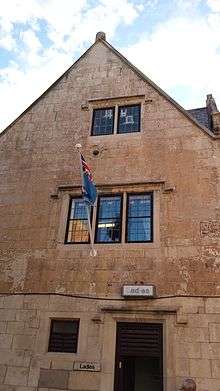Battle of Weymouth

The Battles of Weymouth, and the associated Crabchurch Conspiracy occurred in 1645, during the English Civil War, when several royalist plotters within the twin towns of Weymouth and Melcombe on the Dorset coast conspired to deliver the ports back into the control of Charles I.
Early battles
Weymouth, although protected by earthworks and ditches, was generally undefendable against any serious effort to take it.[1][2] The harbour was well-protected by Sandsfoot Castle, but the town itself had little in the way of serious fortifications.[1] The town had previously been taken by the Royalists in August 1643, before being forced to surrender by Robert Devereux, 2nd Earl of Essex in 1644.[1] William Sydenham was appointed governor, and took his Regiment of Foot to garrison the town.[1] By the Autumn, Nothe Fort and Chapel Fort had been constructed, along with more earthworks around the town.[1] The Regimental Preacher, Peter Ince, said of the defences that "we were in as sweet a quiet and security as any garrison in the Kingdom; no enemy near us but one at Portland, and that not very considerable, being but about 300 or 400 men".[1]
First battle of Weymouth
| First Battle of Weymouth, or Crabchurch Conspiracy | |||||||||
|---|---|---|---|---|---|---|---|---|---|
| Part of English Civil War | |||||||||
| |||||||||
| Belligerents | |||||||||
| Royalists | Parliamentarians | ||||||||
| Commanders and leaders | |||||||||
| Lewis Dyve | William Sydenham | ||||||||
| Units involved | |||||||||
| Unknown | One regiment of foot | ||||||||
| Strength | |||||||||
| 1,500 | 1,200 | ||||||||
Weymouth still had Royalist sympathisers, however, and with the help of Royalist forces from nearby, they launched attacks on 9 February 1645 both the Chapel and Nothe forts and held them until the following day, when Lewis Dyve and William Hastings arrived with 1,500 men to clear out any resistance and garrison the town for Charles I.[1] They also tried to assassinate Sydenham, but were unsuccessful - although Sydenham lost his brother Francis in the initial assault.[2] This was known locally as the Crabchurch Conspiracy.[2]
The defending Parliamentarians, under William Sydenham, to take refuge in nearby Melcombe, which was at the time only connected to Weymouth proper by a drawbridge.[1] The two sides began to bombard each other from across what is now Radipole Lake and the old harbour.[1]
Second battle of Weymouth
| Second Battle of Weymouth | |||||||||
|---|---|---|---|---|---|---|---|---|---|
| Part of English Civil War | |||||||||
| |||||||||
| Belligerents | |||||||||
| Royalists | Parliamentarians | ||||||||
| Commanders and leaders | |||||||||
| Lewis Dyve | William Sydenham | ||||||||
| Units involved | |||||||||
|
4,500 troops from Dorchester |
One regiment of foot | ||||||||
| Strength | |||||||||
| 6,500 | 1,200 | ||||||||
In order to retake Weymouth, Parliament dispatched the warship Constant Reformation under William Batten, with 200 sailors from Poole, and 100 cavalry under James Heane who had made their way through enemy lines and met up with Parliamentarians in Melcombe.[1] In total, there were 1,200 Parliamentarians in Melcombe, facing against a numerically stronger, but less experienced and thus weaker force of 1,500 Royalists in Weymouth.[1]
A 4,500-strong Royalist army under Lord Goring was based in nearby Dorchester, but did not move to intervene in the internecine bombardment.[1] On February 27, Sydenham saw his chance, and captured a Royalist supply convoy on its way to Weymouth from Dorchester.[1] When Dyve moved troops to recapture the convoy, the Parliamentarians stormed the bridge with 150 musketeers, taking the town, and eventually both the forts.[1]
Goring immediately marched down to retake the town with a combined force of 6,500 men - but the attack was repulsed by Sydenham and Batten.[1] Those royalists involved in the conspiracy were, for the main part, executed.[1][2]
References
- 1 2 3 4 5 6 7 8 9 10 11 12 13 14 15 16 Manganiello, Stephen C. (2004-01-01). The Concise Encyclopedia of the Revolutions and Wars of England, Scotland, and Ireland, 1639-1660. Scarecrow Press. ISBN 9780810851009.
- 1 2 3 4 Vine, Mark (2013). The Crabchurch Conspiracy 1645: The true story of Dorset's bloodiest secret. Sherrens. ISBN 9780992783501.